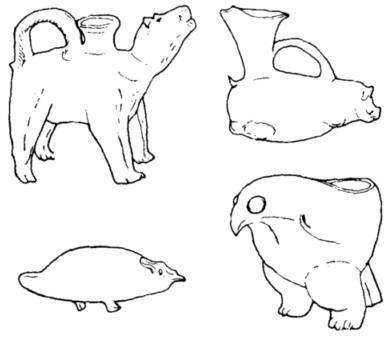Chapter 15 The third section is meticulously carved
Sculpture, as a means of beautifying life, was widely used in the Neolithic Age. We have now discovered a large number of sculptures of that era, including many primitive art treasures.The materials used in these carvings include bone, teeth, pottery, stone, etc., and there are line carvings, relief sculptures and round sculptures.There are quite a few subsidiary sculptures on some genus utensils, and there are also some single sculptures, all of which shine with the wisdom of prehistoric ancestors.
Bone and tooth carvings are delicate and elegant works of art, mostly from Neolithic cultural sites distributed in the eastern region.For example, the bone dagger carved with double phoenix patterns at the Hemudu site, the pig head carved with pig teeth at the Liulin site in Pixian County, Jiangsu, the openwork ivory cylinder and ivory comb at the Dawenkou cemetery in Tai'an, and the bone at the Hejiawan site in Xixiang, Shaanxi. Carved heads are all rare carving treasures.
There are many pottery sculptures found in archeology. Although pottery sculptures are more random, there are also many excellent ones, mainly realistic human and animal figures.For example, the statue of a goddess at the Dongshanzui site in Kazuo, Liaoning, the painted pottery vase with a human head and mouth at the Dadiwan site in Qin’an, Gansu, the owl-shaped tripod in Taipingzhuang, Huaxian County, Shaanxi, the dog-shaped pottery at Dawenkou in Tai’an, and the pig-shaped pottery at Sanlihe in Jiaoxian County, etc. , have high artistic appreciation value.
There are relatively few stone carvings found, which are not enough to reflect the level of technological development in prehistoric times.The stone-carved human heads in Yuanyangchi, Yongchang, Gansu, the stone-carved monkeys in Shangzhai, Pinggu, Beijing, and the double-faced human-headed stone carvings in Daxi, Wushan, Sichuan, etc., these discoveries are quite eye-catching.
In addition, a large number of chiseled or painted rock paintings on cliffs have been found in the south and north, some of which can be traced back to the Neolithic Age and belong to the works of prehistoric people.The contents of the petroglyphs are mainly the reproduction of hunting and grazing activities, and most of the pictures showing various animals are obviously not left over from farming tribes.These simple and rough works have eternal charm, showing us a true picture of prehistoric human activities.
The basic technique of engraving technology has sprouted as early as the late Paleolithic period when making small ornaments, and has been greatly developed in the Neolithic period, with a wide range of materials and various expression techniques, and the works are becoming more and more exquisite.Early Neolithic sites in the Central Plains have unearthed a small number of sculptures, most of which are small pottery sculptures, which are relatively rough and show themes of humans and animals.Entering the period of prosperity and development of Neolithic culture, the art of sculpture and sculpture improved significantly.During this period, the middle and upper reaches of the Yellow River mainly focused on human beings, and it was popular to attach human heads and human figures to pottery.In the downstream area, animal shapes are mainly displayed, and even the entire utensils are molded into animal shapes. On the contrary, human bodies are never represented, and no human body art works have been seen (Fig. 14).A small number of carvings have also been unearthed in the middle and lower reaches of the Yangtze River.The number of small animals found in the middle reaches is very small, the characteristics are not obvious, and there are animal themes. Among them, several batches of pottery small animals have been unearthed from the Shijiahe site in Tianmen, Hubei, mainly including apes, elephants, birds, dogs, rabbits, sheep, chickens, ducks, Turtles, owls, etc., as well as a small amount of human body pottery sculptures, are rare and important discoveries.Bone, tooth, and wood carvings are common in the lower reaches of the Yangtze River. The themes are animals and plants, and there are few human figures. Line carving is the main method of expression, which is delicate and vivid.The Liangzhu culture has a well-developed jade carving technique, mostly using line carving and relief carving, mainly expressing delicate animal face patterns, and there are also realistic jade birds and jade turtles.The Hongshan culture in the northern region also has well-developed jade carving techniques, including pottery and clay figurines, with tall figures and strong realistic style.

Figure 14 Neolithic pottery representing animal figures
Sculpture and engraving handicrafts, as plastic arts, have specific meanings in prehistoric society, and are not purely handicrafts.Like other handicrafts, sculptures also express the beliefs and pursuits of prehistoric people, and even most of the works have their specific meanings, mostly closely related to primitive religion and witchcraft, which we will talk about later.There are not no works of art that truly express the interest of nature, at least not mainstream.It is in this primitive belief and pursuit that the level of carving technology has been improved step by step, the taste of beauty has gradually developed to a high level, and some high-level handicraft artists have also been cultivated in that era.Many exquisite carving handicrafts cannot be made by people without special skills, not to mention jade carving crafts that require special equipment.
The tradition of Chinese carving art, which originated in prehistoric times, was inherited and carried forward in the Bronze Age. The bronze decorations, whether geometric or animal, were developed on the basis of the original styles of the prehistoric era.From this point of view, the root of art is basically planted in prehistoric times. With the development of society, the tree of art has gradually flourished.

Figure 14 Neolithic pottery representing animal figures
